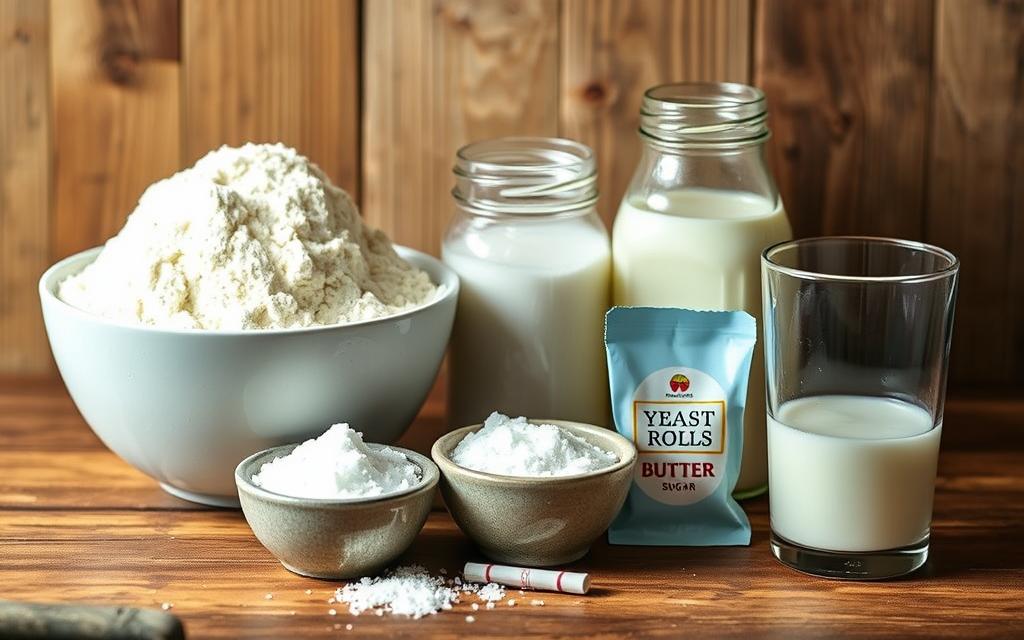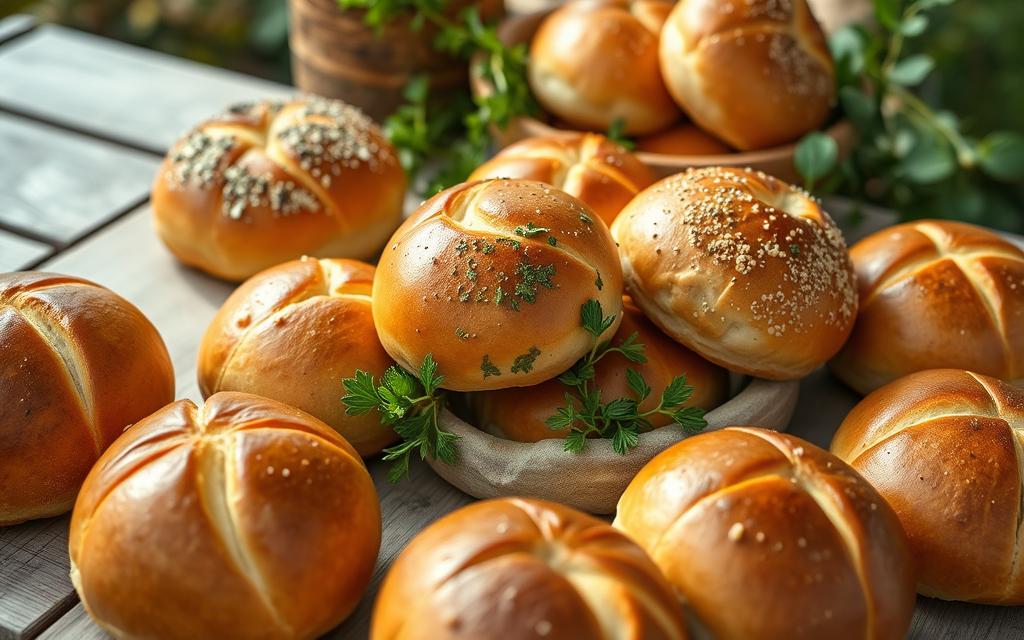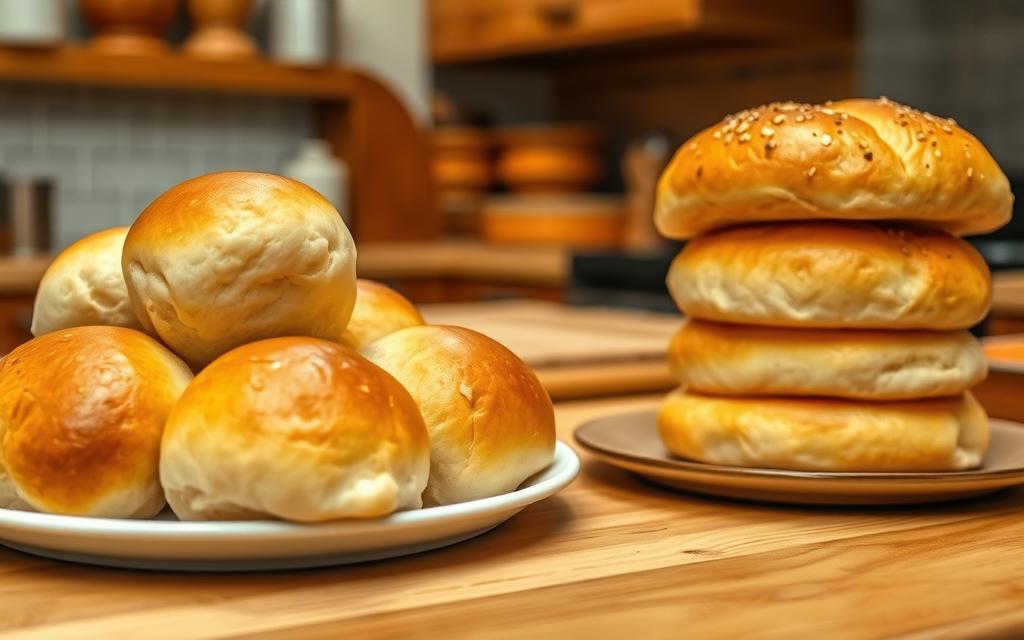Ever wondered what sets a bun apart from a dinner roll? This question has sparked debate among bakers and chefs. Each has its own unique traits and uses. Knowing the difference is key to baking delicious dishes.
Exploring buns and dinner rolls reveals their distinct ingredients, textures, and uses. Whether you’re an experienced baker or just starting, understanding these basics is crucial. So, how do you choose the right one for your recipes?
Key Takeaways
- Understanding the difference between buns and dinner rolls is essential for creating authentic dishes
- Buns and dinner rolls have distinct ingredients, textures, and traditional uses
- Choosing the right type of bun or dinner roll depends on the recipe and desired outcome
- Buns and dinner rolls can be used in a variety of dishes, from savory meals to sweet treats
- Exploring the world of buns and dinner rolls can help you develop new recipes and baking skills
- Learning about the cultural significance of buns and dinner rolls can add depth to your baking experience
- With practice and patience, you can master the art of baking delicious buns and dinner rolls
Understanding the Basics of Buns
Many people wonder about the difference between buns and rolls. Let’s start with what a bun is. A bun is a small, round, soft bread. It’s made from yeast, flour, and sugar.
There are many kinds of buns, each with its own special features. They are found in many cuisines, like Asian steamed buns and European dinner rolls. Knowing the types and uses of buns is key.
Sandwich buns hold fillings like meat and cheese. Sweet buns are topped with sugar and cinnamon. This makes them perfect for desserts.
- Sandwiches: buns are a great base for sandwiches, providing a soft and sturdy foundation for fillings.
- Desserts: sweet buns can be topped with a variety of ingredients, such as sugar, cinnamon, or fruit, to create a delicious dessert.
- Side dishes: buns can be served as a side dish, often accompanied by soups, stews, or salads.
Understanding buns helps you choose the right bread for your recipes. This knowledge makes cooking and baking easier.
Exploring Dinner Rolls
Dinner rolls come in many types, each with its own special qualities. Knowing the difference between dinner rolls and buns is key to picking the perfect one for your meal. Let’s explore the world of dinner rolls, including their definition, types, and traditional uses.
Dinner rolls offer a variety of flavors and textures. You can find everything from classic white rolls to whole wheat and sourdough. Some favorites include:
- Butter dinner rolls, perfect for serving alongside soups and stews
- Garlic dinner rolls, great for accompanying roasted meats and vegetables
- Herb dinner rolls, ideal for pairing with salads and light meals
Dinner rolls are versatile, used as a side dish, a sandwich base, or with soups and stews. Knowing the different types and uses helps you choose the right roll for your meal.
Looking for a classic roll or something unique? There’s a dinner roll for everyone. By exploring dinner rolls and understanding the differences, you can enhance your meals and add warmth to your dining experience.
Key Ingredients in Buns
The type of flour used in buns greatly affects the final product. You can pick from all-purpose flour, bread flour, or pastry flour. Each has its own special traits. For instance, bread flour has more protein, making buns chewier. Pastry flour, with less protein, is better for soft pastries.
In the bun vs bread debate, ingredients play a big role. Buns often have extras like sugar, yeast, and salt. These add to the taste and feel. The difference bun and dinner roll comes from the ingredients and how they’re made. Dinner rolls have more butter and eggs, making them soft and flaky.
By mixing these ingredients in different ways, you can make many types of buns. Each one has its own taste and texture.
In short, making tasty buns is all about the ingredients and how you prepare them. Knowing about the different flours and additives helps you make various buns. Whether you like a simple bun vs bread or a fancy dinner roll, you can make it.
| Ingredient | Function |
|---|---|
| Flour | Provides structure and texture |
| Yeast | Helps the dough rise |
| Sugar | Enhances flavor and browning |
Key Ingredients in Dinner Rolls
Dinner rolls and bread differ mainly in ingredients. Dinner rolls are lighter and fluffier than buns. This is because of the flour used.
Flour Variations
Flour types like all-purpose, bread, and pastry flour are used in dinner rolls. Each flour has its own protein content and texture. These factors influence the roll’s final taste and feel.

Sweet vs. Savory Rolls
Dinner rolls can be sweet or savory. Sweet ones might have sugar, honey, or fruit. Savory rolls might have herbs, cheese, or nuts. The choice depends on what you like and the event.
Enhancements and Toppings
Enhancements like sesame seeds, poppy seeds, and herbs can be added to dinner rolls. These can be mixed into the dough or sprinkled on after baking. They add flavor and texture.
Nutritional Comparison: Buns vs. Dinner Rolls
Understanding the nutritional content of buns and dinner rolls is key. This knowledge helps you choose the right one for your meals. A comparison shows differences in calories, macronutrients, and fiber and whole grain options.
Caloric Differences
A typical bun has 100 to 200 calories, depending on its type and size. Dinner rolls usually have 80 to 150 calories per serving. While the calorie difference is small, it can add up if you eat many in one sitting.
Macronutrient Breakdown
Buns and dinner rolls are mostly carbs. But, some dinner rolls might have more protein because of eggs or other protein-rich ingredients. Here’s a look at their macronutrient breakdown:
| Food Item | Carbohydrates | Protein | Fat |
|---|---|---|---|
| Bun | 30-40g | 5-10g | 2-5g |
| Dinner Roll | 25-35g | 5-15g | 2-5g |
Fiber and Whole Grain Options
Some buns and dinner rolls have more fiber and whole grains than others. Choose ones made with whole wheat flour or other whole grains for more fiber. Adding nuts, seeds, or dried fruits can also boost fiber and nutrition.
Cultural Significance of Buns
Exploring the bun vs dinner roll debate shows us the cultural importance of buns. Buns are a key part of many cuisines worldwide, each with its own twist. They symbolize hospitality, community, and celebration in many cultures.
In Asia, buns are a favorite, with fillings from sweet to savory. Chinese bao and Japanese melon pan are well-known. The bun vs roll debate fades when we see the variety of buns globally. From Mexico’s bolillo to India’s pav, each bun reflects local tastes and ingredients.
- Chinese bao: steamed buns filled with pork, vegetables, or sweet fillings
- Mexican bolillo: a crusty bun often used for sandwiches or toast
- Japanese melon pan: a sweet bun with a crispy cookie-like topping
These examples show the rich cultural heritage of buns. Whether you prefer a bun vs dinner roll, it’s all about what you like and the occasion.
Exploring buns reveals their unique qualities, from texture to taste. The bun vs roll debate may seem small, but it reflects the variety of culinary traditions around the world.
| Type of Bun | Origin | Fillings |
|---|---|---|
| Chinese bao | China | Pork, vegetables, sweet fillings |
| Mexican bolillo | Mexico | Meat, cheese, vegetables |
| Japanese melon pan | Japan | Sweet fillings, red bean paste |
Cultural Significance of Dinner Rolls
Dinner rolls and buns have their own special places in different cultures. In American and European cooking, dinner rolls are a big deal. They come in many types, like classic American rolls and Italian grissini.
Dinner rolls are often seen as more fancy than regular bread. They’re perfect for big events like holidays and weddings. They’re also a key part of fancy dinners.
Regional Variations in Dinner Rolls
Dinner rolls vary a lot by region. Here are some examples:
- Italian grissini: long, thin rolls great with olive oil and herbs
- French baguette rolls: crusty and chewy, perfect for sauces
- American dinner rolls: soft and fluffy, great with butter or jam
Dinner Rolls in Different Cuisines
Dinner rolls are loved in many cuisines. They’re great as a side or in recipes. You can make sliders or appetizers with them.
In short, dinner rolls mean a lot more than just what they’re made of. Whether you’re talking about dinner rolls vs buns or dinner rolls vs bread, they’re a favorite food. They’re enjoyed in many ways.
| Type of Dinner Roll | Region | Description |
|---|---|---|
| Grissini | Italy | Long, thin dinner rolls often served with olive oil and herbs |
| Baguette Rolls | France | Crusty, chewy dinner rolls perfect for sopping up sauces |
| American Dinner Rolls | United States | Soft, fluffy dinner rolls often served with butter or jam |
How to Choose: Buns or Dinner Rolls?
When picking between buns and dinner rolls, think about the event and the meal. A bun or dinner roll can change how you enjoy your food. For instance, a hearty stew goes well with a crusty dinner roll. But, a juicy burger is often served on a soft bun.
Buns are great for everyday meals like sandwiches or burgers. Dinner rolls, on the other hand, are perfect for formal events or holiday meals. Your choice depends on what you like and the taste you want. If you prefer something light, a dinner roll might be better. But, if you like a denser texture, choose a bun or dinner roll with more yeast.
Here are some things to think about when deciding between buns and dinner rolls:
- Meal type: Casual or formal
- Flavor profile: Light and airy or dense and chewy
- Texture: Soft and fluffy or crusty and crunchy

By considering these points and knowing the difference between buns and dinner rolls, you can pick the perfect match for your meal. Whether you choose a bun or a dinner roll, aim for the right mix of taste and texture to make your meal better.
| Occasion | Bun or Dinner Roll |
|---|---|
| Casual meal | Bun |
| Formal event | Dinner roll |
| Special occasion | Either, depending on personal preference |
Best Cooking Methods for Buns
There are many ways to cook buns for the best taste and texture. You can bake or grill them. Baking in a conventional or steam oven gives a crispy crust and soft inside. This is great for different bun kinds, as some need more moisture.
Grilling is another excellent option. It adds a char and texture, making buns great with your favorite dishes. Brushing with oil or butter enhances the flavor. Some dinner roll types also grill well, offering a tasty alternative to baking.
- Using a steam oven to create a crispy crust
- Brushing with egg wash for a golden brown color
- Adding toppings such as sesame seeds or poppy seeds for extra flavor
Try these methods to find the best way to cook your buns. Enjoy them with your favorite meals.
Best Cooking Methods for Dinner Rolls
There are many ways to cook dinner rolls for the best taste and texture. You can choose between a classic bun or a dinner roll. We’ll look at the top cooking methods, including baking tips and serving ideas.
Baking Tips
To bake dinner rolls, use a conventional oven or a toaster oven. Here are some tips to keep in mind:
- Preheat the oven to the right temperature (usually around 375°F) to ensure the rolls cook evenly.
- Use a baking sheet lined with parchment paper to prevent the rolls from sticking.
- Brush the rolls with egg wash or melted butter to give them a golden brown color.
Serving Suggestions
Dinner rolls can be served in many ways, depending on the occasion. Here are some ideas:
- Serve warm dinner rolls with a pat of butter or a side of jam for a classic breakfast or brunch option.
- Offer dinner rolls as a side dish for dinner, paired with a hearty soup or stew.
- Use dinner rolls as a base for sliders or sandwiches for a quick and easy snack.
By following these baking tips and serving suggestions, you can make delicious dinner rolls. Whether you like a bun or a dinner roll, try different cooking methods and ingredients to find your favorite.
Storage Tips for Buns and Dinner Rolls
Storing buns and dinner rolls right is key to keeping them fresh. Whether you’re comparing buns to dinner rolls, the storage tips are the same. You can store them at room temperature, in the fridge, or freeze them.
For a short time, keep them at room temperature in a cool, dry spot. This works for a day or two. For longer, refrigerate them to stay fresh for up to a week. Always use an airtight container to keep their texture.
Best Practices for Freshness
Keeping buns and dinner rolls fresh means storing them right. Use a paper bag or a breathable container to let air in. This stops moisture buildup and keeps them fresh longer.
Freezing Techniques
Freezing is great for longer storage. You can freeze them for up to three months. Wrap them tightly in plastic or foil to avoid freezer burn. Use a freezer-safe bag too.
When you’re ready to use frozen buns or dinner rolls, thaw them at room temperature or reheat in the oven. This brings back their texture and freshness. Follow these tips to enjoy your buns and dinner rolls longer, whether you prefer buns or rolls.
Conclusion: Buns vs. Dinner Rolls
The main difference between buns and dinner rolls is their shape and size. Buns are bigger and sturdier, great for sandwiches or burgers. Dinner rolls are smaller and softer, perfect as a side dish.
Summary of Differences
Buns have a crunchy crust and a chewy texture. Dinner rolls are light and fluffy. The ingredients in each can differ, with buns sometimes having extra fats or sweeteners.
When to Use Each Type
Think about the occasion and the meal when deciding between buns and dinner rolls. Buns are perfect for sandwiches, burgers, or other handheld foods. Dinner rolls are better for soups, stews, or formal meals.
section>

